
Architects: J.Th.J. Cuypers (1861-1949)
Joseph Theodorus Joannes Cuypers was born in Roermond on June 10th 1861 as the son of the famous P.J.H. Cuypers. The family moved to Amsterdam in 1865 where he spent part of his youth until he was sent to the Rolduc boarding school near Kerkrade, Limburg, where he stayed for seven years for primary and secondary education. After his graduation he studied at the Delft Polytechnic from 1879 till 1883, where he graduated as both an architectural and a civil engineer. The next year he worked at his father's office and designed and built his first building, a house. After this year he travelled for seven months through several countries in Europe.
In 1885 he became his father's assistent, first at the Roermond office. In 1889 his first church was built. In the 1890's he was gradually trusted with more of his father's work. In 1894 Jos. replaced his father, who now spent much of his time in Valkenburg, as head of the Cuypers office in Amsterdam. From that moment on there are a few churches officially credited to P.J.H. where at least a big influence of Jos. can be suspected. While working for his father he also designed under his own name, and work on his most important work, Haarlem's cathedral, was started in this period. Like his father, he was still a neo-Gothic architect at that time. In the same period Cuypers was commissioned to design a second cathedal, for Rangoon, Burma. Although a first design showed a major influence of Asian traditional architecture, the colonial church authorities disapproved and made Cuypers' use a strict European neo-Gothic style instead.
In 1900 Jos. associated himself with Jan Stuyt, another employee of the Cuypers office. Although the partnership only lasted for nine years, it was a very fruitful period in which the two architects ended the dominant position of neo-Gothic in catholic church architecture, introducing Romanesque and Byzantine influences on a scale larger than before. However, it is suspected, and in some cases certain, that Stuyt was largely responsible for the more neo-Romanesque designs. Both architects were among the founding members of 'De Violier', a catholic arts society founded in 1901 in response to the conservatism of the neo-Gothic minded St. Bernulphus Guild.
In 1912 the partnership with his father was formally dissolved, leaving Joseph in charge of the Cuypers firm. A year later he formed a new partnership with his son Michael. In 1915 Cuypers sold his house in Amsterdam and returned to Roermond. In 1918 his oldest son P.J.J.M Cuypers (Pierre jr. 1891-1982) joined the office and in 1920 became his father's associate. Little is known about Pierre jr.'s education and early architectural career, except that in 1922 he worked with monk-architect Dom Bellot in Oosterhout. By 1923 he had his own office in Amsterdam, in the same street as the old Cuypers office. The new partnership saw another change in style for the Cuypers firm. Many churches from this period show the influence of Dom Bellot's Expressionist style, such as the shape of windows and the use of glazed bricks. The partnership with his father did not restrict Pierre from accepting assignments of his own. In 1926 he even assisted Dom Bellot at the design for a church in Waalwijk.
In 1944 or 1945, depending on the source, Jos. Cuypers was forced to leave Roermond. He spent the final years of his life in Meerssen, first in a convent and later in the presbytery where he died on January the 20th 1949. The Cuypers firm in Roermond continued under the leadership of Pierre Jr. but it never regained its former glory. No further churches were built. In 1957 Pierre Cuypers jr. left the Roermond office to former employee H. Huisintvelt and his associate J. Deltrap but continued the Amsterdam office himself at least until 1959. One of Cuypers' last assignments was the design of the national aviation school in Eelde (Dr) in 1957, the very last was for a granary in Amsterdam (1959-1961). For part of the 1950's and 1960's he was vice-president of the Royal Dutch Aviation Society (KNVvL), having been involved in aviation since the 1930's.
Besides building churches, Jos. Cuypers also restored many of them, as well as designing several profane buildings. His most important non-religious work is the stock-exchange in Amsterdam.
The following list concentrates on churches primarily, but profane work ands restorations will be added gradually. Items are arranged in the best possible chronological order. This list also includes all churches designed as part of the Cuypers-Stuyt companionship, including those mostly designed by Stuyt, as well as those designed by Pierre Cuypers jr..
In this period Cuypers designed both houses and churches while working for his father at the same time.
1884 Amsterdam (NH): pension Oud Leyerhoven
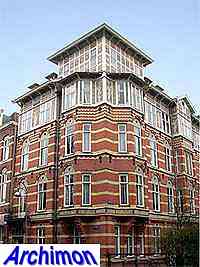
Cuypers' first design, a house in neo-Renaissance style.
1889-1891 Nes aan de Amstel (NH): church St. Urbanus
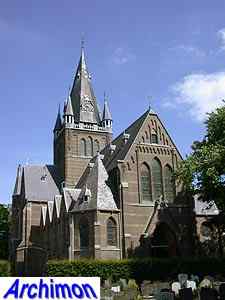
Cuypers' first church is built in a mix of neo-Gothic and neo-Romanesque styles and has a big square tower at the crossing, similar to much of his father's later work, notably the St. Augustinus in Nijmegen (G). Deep choir. The interior is one of the first examples of the use of brick in different colours.
1890 Aarlanderveen (ZH): church H.H. Petrus en Paulus
Three-aisled church with wide central aisle and narrow side-aisles. Narrow transept. Choir with 5-sided closure and rectangular lateral chapels.
1891-1892 Sas van Gent (Z): church O.L. Vrouw Hemelvaart
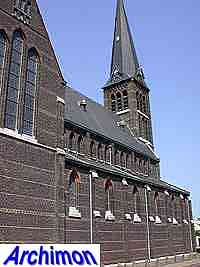
Three-aisled basilican church in modest neo-Gothic style.
1893-1894 Enschede (Ov): church St. Jozef
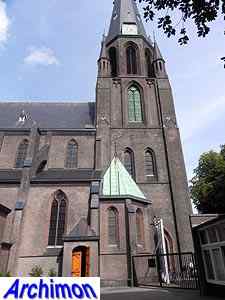
Three-aisled basilican church in neo-Gothic style. Nave very similar to P.J.H. Cuypers' St. Jozef in Groningen (Gr). Tower with octagonal upper segment. In 1953 a chapel was added by J. Sluymer.
1895-1933 Haarlem (NH): St. Bavo cathedral
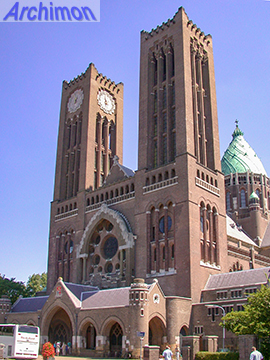
Started before Cuypers' partnership with Jan Stuyt, who was the head-overseer at this project until 1898 and contributed much to the building in the next ten years. Originally designed in Neo-Gothic style, this church eventually showed influences from Romanesque, Byzantine and Jugendstil architecture. Work was carried out in three stages. From 1895 to 1898 the choir and chapels were built, with the construction of the main part of the church following from 1902 until 1906. Work on the towers and front portals did not start until 1927, to be finally finished in 1930.
1896-1897 Zutphen (G): restoration Vleeshuis
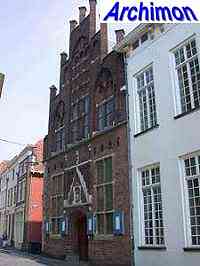
Restoration of a medieval Gothic building. Reconstruction of gable in neo-Gothic style.
1897-1898 Goirle (NB): church St. Johannes' Onthoofding
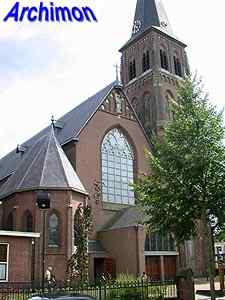
Three-aisled neo-Gothic cruciform church. The tower of the 15th-century predecessor was heightened and incorporated.
1898-1899 Project for a cathedral in Rangoon, Burma
There are two different designs. The first is a mix of ideas for the cathedral in Haarlem and Asian influences in details and the dome. The second design is a much more conventional neo-Gothic church. This second design was chosen, although ultimately the finished church (1908) shows many differences with Cuypers' design.
1898 Oude Tonge (ZH): church H. Maria Hemelvaart
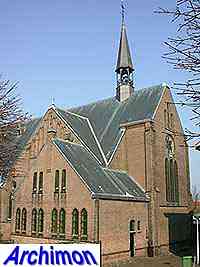
Small neo-Gothic church with steeple-tower on the roof. Similarities with P.J.H. Cuypers' church in Nes op Ameland. Traves of side-aisles have gables and saddle-roofs. The traves next to the transept share its roof. Short rectangular choir.
1899 Rheden (G): Hotel De Roskam
Hotel in cottage-style.
This is a very fruitful period, with some famous creations. It's not always clear who did what, though, but it is suspected that churches in neo-Romanesque style were mostly the work of Stuyt. For practical reasons these works are listed on this page as well. Jan Stuyt's work before and after the partnership is covered on a separate page.
1900-1903 Steenbergen (NB): church St. Gummarus

Originally a design by P.J.H. Cuypers to whom this church is often credited, but drastically altered by J. Cuypers and J. Stuyt. This is a centralizing cruciform church built in a combination of neo-Romanesque and neo-Gothic styles, with a huge cone-shaped spire on top of the central tower. In 1927 a chapel was added and the south entrance enlarged to prevent sagging.
1901 Oegstgeest (ZH): church St.Willibrordus
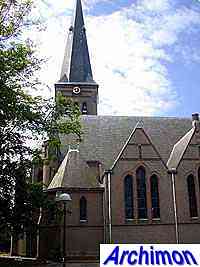
Three-aisled neo-Gothic church. Side-aisles divided in 5 traves, each with a triplet-window, a gable and a saddle-roof square on the higher roof of the nave. Tall tower next to the choir. 1901 is year of consecration.
1901-1902 Apeldoorn (G): extension church O.L. Vrouwe ten Hemelopneming
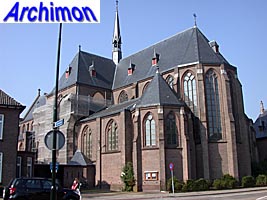
Transept and choir added to a church dating from 1896-1898, designed by J.W. Boerbooms.
1901-1902 Ginneken (NB): church St. Laurentius
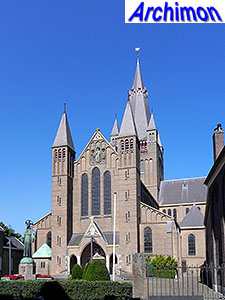
A big village-church built in a combination of neo-Gothic and neo-Romanesque styles, with a tall square tower on the crossing.
1901-1903 Heerlen (L): restoration and enlargement church St. Pancratius
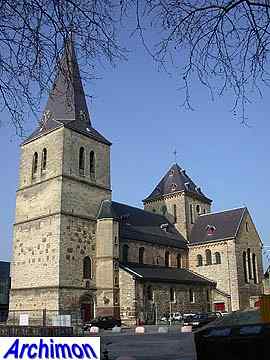
Addition of a transept with square crossing-tower and a new choir, all in neo-Romanesque style, to a Romanesque church. Probably by Cuypers alone.
1902-1903 Utrecht (U): church Antonius van Padua
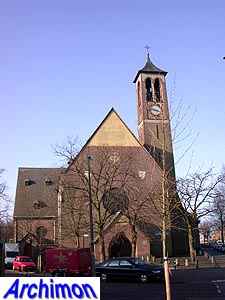
Cruciform church with a round apse and a tower in Italian style. This was the first catholic church for centuries in Utrecht that was not built in neo-Gothic style. This church was probably mostly designed by Jan Stuyt.
1902 Handel (NB): rebuilding church Maria Hemelvaart
Alterations to an older church. New choir, addition of side-aisles to the three eastern traves of the nave.
1902-1905 Leende (NB): restoration tower St. Petrus' Banden
Restoration of medieval church tower. Strengthening of the construction and replacement of the entrance.
1903-1904 Hamont, Belgium: church St. Laurentius
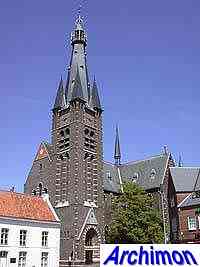
Neo-Gothic cruciform basilican church. 68 metres tall square tower stands offset to the left of the facade, with four corner turrets and a tall spire with gallery on top. Entrance to the church is through the side of the tower. Due to space limits the choir was built shorter than intended.
1903-1904 Zoeterwoude (ZH): church St. Johannes Onthoofding
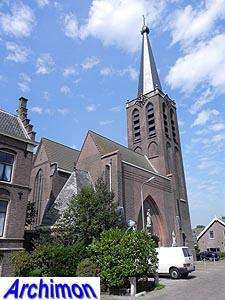
Three-aisled neo-Gothic church with wide central aisle and narrow side-aisles. Traves of side-aisles have gables and saddle-roofs. The tower stands at the western trave of the southern side-aisle. Transept lower than the nave. Partly destroyed by fire in 1964, the remains were turned into a smaller church at the height of the side-aisles.
1903-1904 Haarlem (NH): church St. Johannes de Doper
Aisleless church in neo-Gothic style. In 1925-1926 the church was extended and a tower added. The church was demolished in 1973, with the exception of the tower.
1905 Breda (NB): church St. Anna
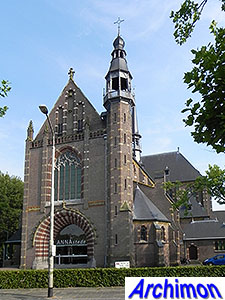
Large three-aisled basilican church in neo-Gothic style inspired by Rhineland Gothic. Low side-aisles. Small tower next to the facade, although place was reserved for a bigger tower on the north side of the church. Recently rebuilt into an office-building.
1906-1909 Oud-Zevenaar (G): enlargement church St. Martinus
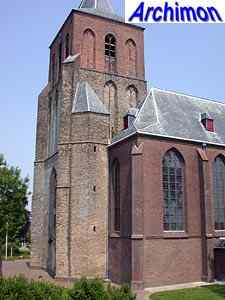
Replacement of the southern side-aisle by a taller one in neo-Gothic style. Built in 1909.
1906 Roermond (L): St. Ursulakapel
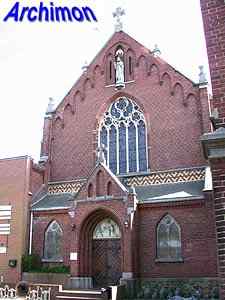
Chapel in neo-Gothic style for an Ursuline convent. Probably by Cuypers alone.
1906-1907 's-Hertogenbosch (NB): church St. Jacob
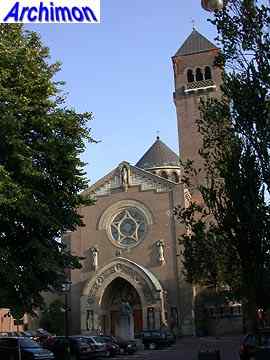
Church inspired by Italian, Byzantine and Romanesque architecture. Built on an almost square piece of land, which made the choice for a centralizing church obvious. Cruciform building with a dome on the crossing. It seems likely that this was mostly a Jan Stuyt design.
1906-1907 Papenhoven-Grevenbicht (L) : church H. Catharina
New church for a parish comprising of two villages, located at a point between the former two churches. Cruciform basilican church in a moderate combination of neo-Gothic and neo-Romanesque styles. Circular windows in the clerestory. The transept is lower than the nave. The tower is positioned in front of the right-side aisle. Round apse.
1906 Zeelst (NB): tower church St. Willibrordus
Square tower with corner-turrets at the top, for the church by C. Weber. Probably by Stuyt alone.
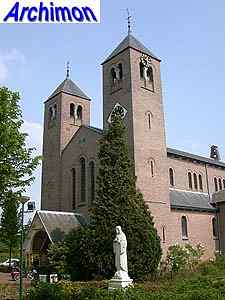
Basilican church in neo-Romanesque style, with two towers at the front. Usually attributed to Stuyt alone. Presbytery in an ecclectic style attached to the church. Very similar to the church in Heerlerheide (L) that was built in 1909.
1907-1908 Groenlo (G): church St. Calixtus
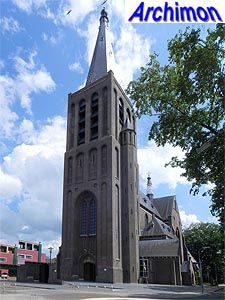
Big but rather conventional neo-Gothic cruciform basilica.
1907-1926 Oirschot (NB): convent Klooster Nazareth
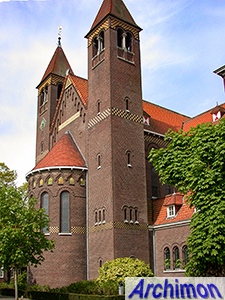
All buildings of this complex were designed by Cuypers and Stuyt, and built in various periods. Includes chapel in neo-Romanesque style with Jugendstil-like tile-decorations.
1907-1908 Wijkeroog (Velsen-Noord, NH): church St. Jozef
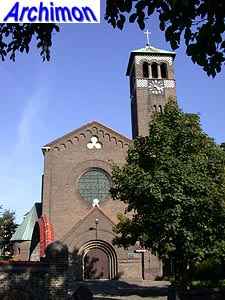
Church in neo-Romanesque style with campanile-like tower. Unspecified work in 1927-1928. Choir extended in 1978. The church was probably designed by Stuyt alone.
1908-1911 Amsterdam (NH): church Allerheiligste Rozenkrans ('Obrechtkerk')
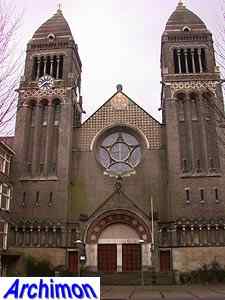
Cruciform church in neo-Romanesque style with square crossing-tower. Of this church only the front is directly visible, and since it was built in a rather rich neighbourhood the facade was richly decorated to give it a touch of class.
1909 Heerlerheide (L): church H. Cornelius
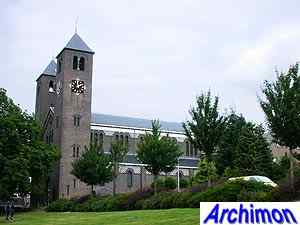
Three-aisled cruciform basilican church in neo-Romanesque style, with two towers at the front and a transept that is lower than the nave. Attributed to Stuyt and Cuypers although their partnership had been dissolved a year earlier, and possibly designed by Stuyt alone.
1909-1910 Alphen (NB): church St. Willibrordus
Replacement of a medieval church, but retaining the tower. Three-aisled nave with a transept that extends a little. Side-aisles with gables and tall windows. Destroyed in 1944 and replaced by a new church by H.W. Valk.
1909-1910 Beek (L): enlargement church H. Martinus
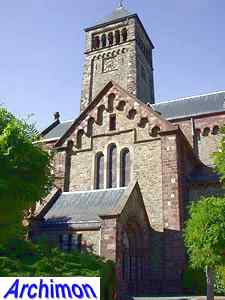
Enlargement of a neo-Romanesque church by L. von Fisenne built in the 1880's and -90's. New tower, extension of the nave with a trave and addition of a second transept.
1910-1911 Duiven (G): church St. Remigius
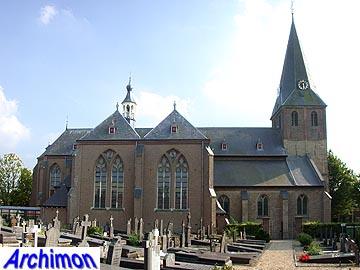
New neo-Gothic double transept with stair-turret and choir added to an otherwise medieval church. Obviously built several years after the plans were finished.
For the next twelve years Cuypers worked alone. In 1915 he returned to Roermond, where in 1920 he associated himself with his son Pierre Jr.,
1911-1914 Amsterdam (NH): stock-exchange
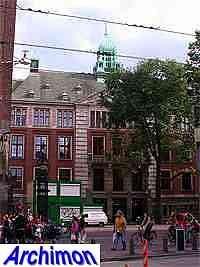
Building in a style inspired by (neo-)Classicism. Regarded as Cuypers' most important profane building.
1911-1912 Halsteren (NB): church St. Quirinus
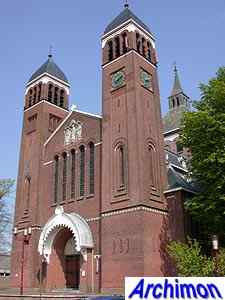
Village-church in neo-Romanesque style with square crossing tower. The towers are simplified versions of those of the St. Bavo cathedral.
1911-1912 Dorst (NB): church St. Marculphus
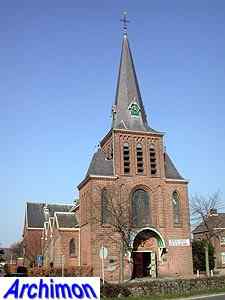
One-aisled cruciform church in neo-Gothic style with westwork-like tower.
1912-1913 Harderwijk (G): restoration chapel St. Catharina
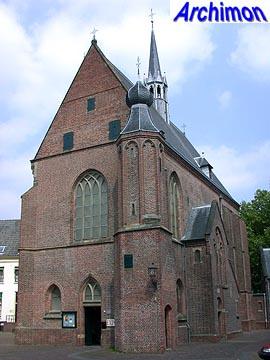
Restoration in Neo-Gothic style of a medieval chapel. Work apparently included the removal of the complete outer layer of bricks and its replacement by new, factory-made stone.
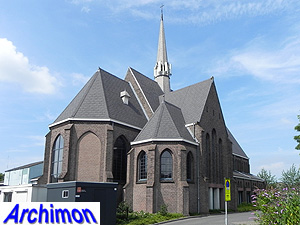
Neo-Gothic chapel for a hospital.
In 1920 Cuypers associated himself with his son Pierre Jr. (1891-1982), although occasionally he also cooperated with several others later. Under the influence of the son the style of the designs changes radically towards Expressionism. Cuypers jr. also designed several churches in a similar style on his own. Because these were designed as part of the association, they are mentioned here as well.
1917-1921 Dongen (NB): church St. Laurentius
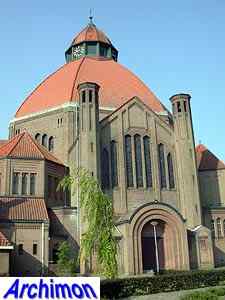
Cuypers' first true dome-church. The original design (1917) included a tower and a nave and features details and ornaments in neo-Byzantine/Art-Deco style. The final design was made in conjunction with P. Cuypers jr. and is largely in Expressionist style. Construction 1920-1921.
1921-1924 Beverwijk (NH): church St. Agatha
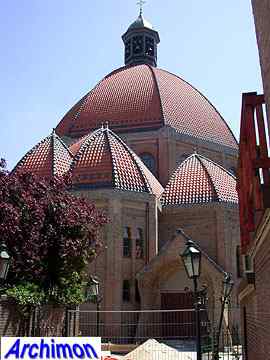
Designed in cooperation with P. Cuypers jr.. An octagonal central space with a big dome with a lantern-tower on top, around which are several smaller spaces such as chapels and the choir, all of which are crowned by domes of their own. Some details are in an Expressionist style.
1921 Bussum (NH): church O.L. Vrouwe
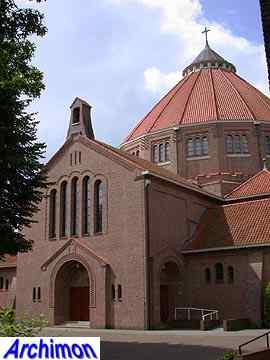
Dome-church in Expressionist style, designed in cooperation with P. Cuypers jr.
1921-1923 Tilburg (NB): church St. Gerardus Majella
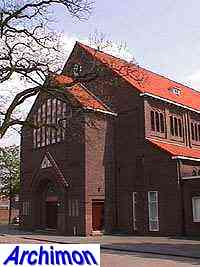
Three-aisled towerless church in Expressionist style. Wide central aisle with narrow side-aisles. Designed in cooperation with P. Cuypers jr.
1922 Aerdenhout (NH): church St. Antonius van Padua
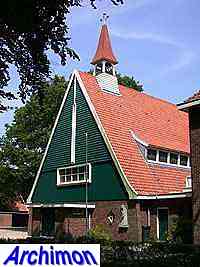
Church in moderate Expressionist style, with a prominent use of wood. Intended as a temporary church but never replaced.
1922 Limbricht (L): church St. Salvius
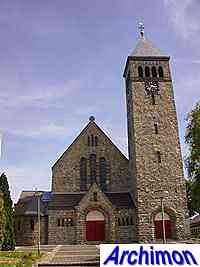
Three-aisled church in neo-Romanesque style, very similar to much of Jan Stuyt's work. Built of irregularly shaped blocks of natural stone. Designed in cooperation with P. Cuypers jr.
Basilican church in a moderate Expressionist style, but with Neo-Gothic elements in the facade. Wide central aisle, low and narrow side-aisles. Steeple at the front. Designed in cooperation with P. Cuypers jr.
1922-1923 Renkum (G): church O.L. Vrouwe Hemelvaart
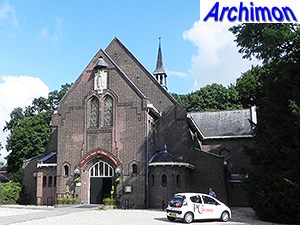
Basilican church in Expressionist style. Double transept, no tower. Designed in cooperation with P. Cuypers jr.
1922-1923 Barger-Oosterveld (Dr): enlargement church St. Gerardus Majella
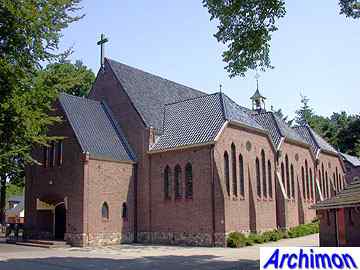
Addition of side-aisles and an extension to the west to an originally neo-Gothic church. In cooperation with P. Cuypers jr.
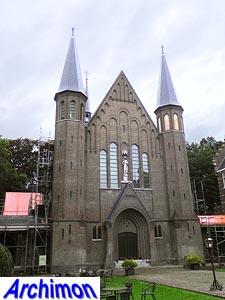
Neo-Gothic chapel replaced the original smaller one as part of a complex by P.J.H. Cuypers.
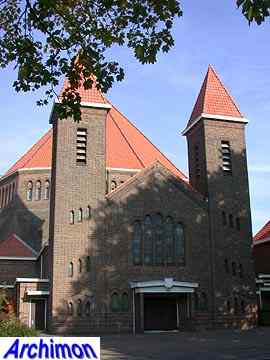
Dome-church in Expressionist style with large octagonal dome and two small towers at the front. Designed by P. Cuypers jr.
1923-1925 Barger-Compascuum (Dr): church St. Jozef
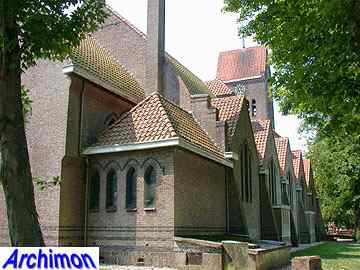
Three-aisled church in moderate Expressionist style. Square choir. Designed in cooperation with P. Cuypers jr. The church was later extended by architect J. Starmans with one aisle and a tower.
1923-1924 Etten (G): church St. Martinus
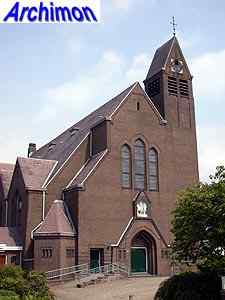
Three-aisled cruciform church with narrow tower with saddle-roof. Designed in cooperation with P. Cuypers jr.
1923-1926 Lattrop (Ov): church H.H. Simon en Judas
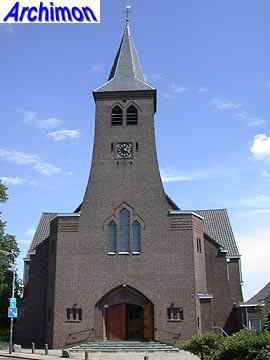
Cruciform basilica in Expressionist/Traditionalist style. Westwork with tower on top.
1924 Schimmert (L): church St. Remigus
Cruciform church with the tower that has a rectangular base, the width being larger than the depth. Tower has a saddle-roof with a spire at the centre. The entire church is build of natural stone. Details inspired by Romanesque architecture. Designed in cooperation with P. Cuypers jr..
1924 Rijssen (Ov): church H. Dionysius
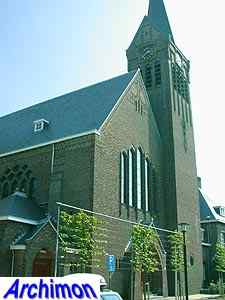
Three-aisled cruciform church in Expressionist style with centralizing ground-plan.
1925-1927 Scheveningen (ZH): church H. Antonius Abt
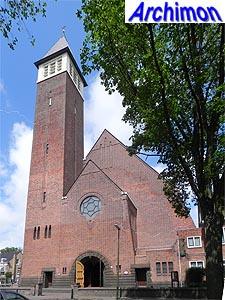
Basilican church in moderate Expressionist style. Designed in cooperation with P. Cuypers jr.
1925-1927 Heemstede (NH): church O.L. Vrouw Hemelvaart
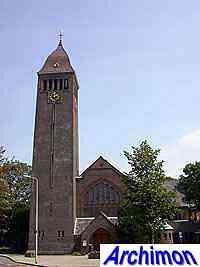
Church in Expressionist style with centralizing ground-plan and a square tower next to the front. Designed in cooperation with P. Cuypers jr.
1925-1927 Rotterdam (ZH): church H. Familie
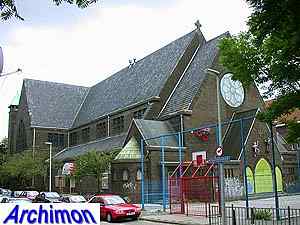
Church in moderate Expressionist style. Designed in cooperation with P. Cuypers jr.
1926-1927 Wehe-Den Hoorn (Gr): church St. Bonifatius
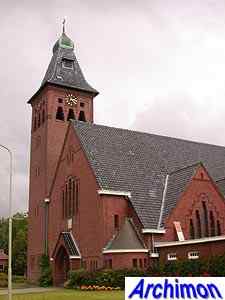
Church in Expressionist style.
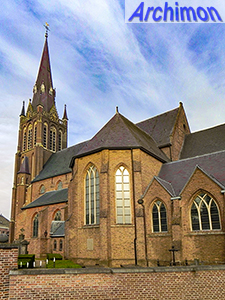
Addition of a transept and lateral chapels in neo-Gothic style to a Gothic church.
1926-1928 Bergen op Zoom (NB): church O.L. Vrouwe van Lourdes
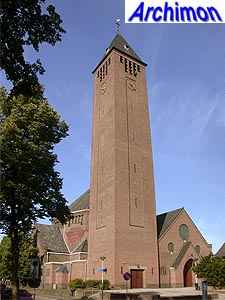
Polygonal dome-church with square tower next to the front. Tower blown up in 1944 and rebuilt after the war. Designed in cooperation with P. Cuypers jr.
1927-1929 Nijmegen (G): Studiehuis Berchmanianum
Jesuite school. Designed in cooperation with P. Cuypers jr.
Three-aisled basilican church in Expressionist style. Designed by P. Cuypers jr.
1930 Nispen (NB): church Maria Hemelvaart
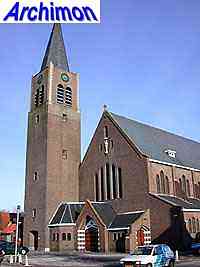
Three-aisled basilican church in Expressionist style, with triplet-windows. Originally incorporated a 17th-century tower, which was destroyed in 1944 and in 1958 was replaced by a new one.
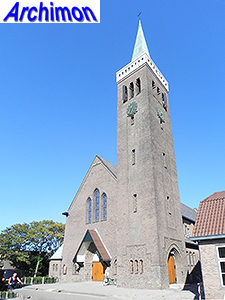
Basilica in Expressionist style, with tall tower. Nave and choir are of the same height and covered by a single roof. Designed in cooperation with P. Cuypers jr.
1931-1935 Hulst (Z): restoration church St. Willibrordus
In conjunction with P. Cuypers jr.. No further details.
Enlargement of C. Weber's neo-Gothic church of 1852. Doubling of the transept, new choir with ambulatory. Designed in cooperation with P. Cuypers jr.
1934 Roosendaal (NB): Franciscanessenklooster Mariadal
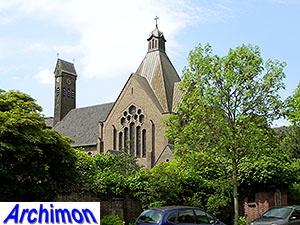
Convent in Traditionalist style, designed in cooperation with F.B. Sturm. Chapel in Expressionist style.
1934 Geleen (L): church St. Augustinus
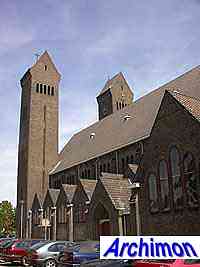
Cruciform
three-aisled
basilican church in moderate Expressionist style, with two towers at
the front and a rectangular choir. Designed in cooperation with P.
Cuypers jr.
1935 Kelpen-Oler (L): church St. Liduïna
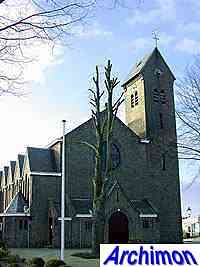
Church in neo-Romanesque style, designed in cooperation with P. Cuypers jr.
1935 Mechelen (L): enlargement church St. Johannes de Doper
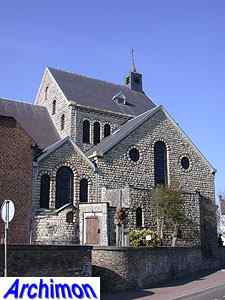
New choir of natural stone in neo-Romanesque style.
1935-1936 Altweerterheide (L): church H. Hart
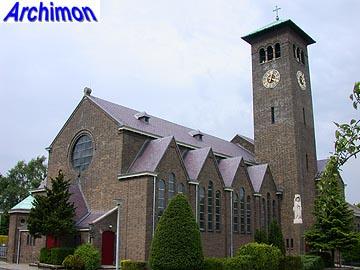
Three-aisled church with rectangular choir, to the side of which stands the tower. Designed in cooperation with P. Cuypers jr.
1936-1938 Meerssen (L): enlargement church St. Bartolomeus
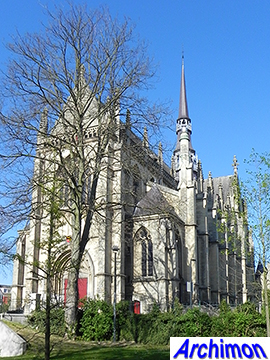
Lengthening of the nave of a Gothic church with three traves in a matching style, although with modern details. New crossing-tower. In conjunction with P. Cuypers jr.. A front tower was desiged but not built.
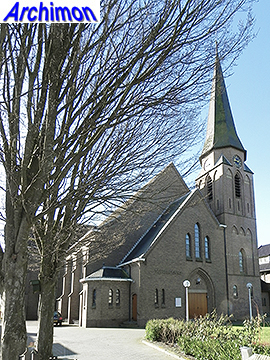
Cruciform pseudo-basilica in Expressionist/neo-Gothic style, incorporating the tower of the previous church by W. te Riele. Often attributed to P. Cuypers jr. alone.
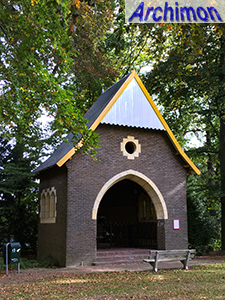
Small chapel.
1940-1941 Haaksbergen (Ov): town hall
Building in Traditionalistic style, designed in cooperation with P. Cuypers jr.
1942 Meerssen (L): Vredeskapel
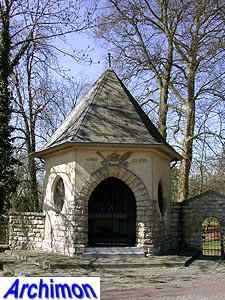
Small hexagonal chapel.